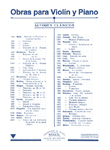Fandango
2 Pianos
SOLER, AntonioReg.: B.4146
27,00 €
P.V.P. (VAT included 4%)
Add to cart
- Arrangement: BRUGALLA, Emili
- Ensemble: Duos: .
- Genres: Classical / contemporary: Arrangements and Transcripts; Chamber.
Flamenco: Fandango.
- Language of the comment: Català/English/Castellano
- Product format: Partitura + particella
- Difficulty level: Intermediate-advanced
- Period: Classical
- Publishing house: Editorial Boileau
- No. of pages: 44
- Measure: 31,00 x 23,00 cm
- Lenght: 00:11:00
- ISMN: 979-0-3503-4354-4
- Available in digital: No
- Available for rent: No
Each copy contains a particella for piano 2
The Fandango by the Catalan composer Antoni Soler is one of the most famous pieces of the 18th-century Iberian keyboard repertoire. Its compositional form links the art of variation - an art that reached very high levels during the Spanish Renaissance and Baroque in the "glosas", "recercadas" or the well-known "Folias de España" - with the conreu of the popular dance pieces that were all the rage in those days in the halls of the Spanish and European aristocracy.
The only manuscript copy of the Fandango is found in the Biblioteca Nacional de Catalunya: It is a copy with the title Fandango de Soler written in the hand of a copyist. The lack of the original manuscript has raised some doubts about the real paternity of the work, but, despite this uncertainty, the Fandango is nowadays considered one of the emblematic pieces of Father Antoni Soler.
The structure of the Fandango is based on an unalterable harmonic scheme in the bass that only modulates sporadically to the key of the major relative with the purpose of breaking the tonal monotony of the work. Over this repetitive bass, a series of increasingly exuberant melodic variations are developed in the middle and high registers of the keyboard, which highlight the virtuosity of the performer -some performers, in their concert versions, have wanted to eliminate certain parts of the work because they consider them too repetitive or uninteresting for public performance-. The Fandango concludes on a dominant chord (de re), in a climate of paroxysm comparable to that of the flamenco dance, remaining, in a certain sense, open or interrupting...
This compositional and interpretative context leads us to consider, therefore, the Fandango as a work that goes 'beyond' its genre and its moment and that clearly benefits from the contribution of the interpreter, who can bring out an important personal creative part and at the same time deflect an excessively purist approach to the work while preserving the sound perfume of popular music of the eighteenth century that characterizes it. This is how the Fandango has gained great popularity over the years, transcribed even by various groups of classical instrumental ensembles or even pop music.
The two-piano version of the Fandango that we present in this edition starts from these premises: it does not pretend to focus on the "letter" of the manuscript, but rather to take advantage of the rich possibilities offered by the simultaneous combination of two keyboards in the art of ornamented improvisation (contrapuntal resources, plays of extreme registers, broadening of the sound palette, etc.).
Presenting it in this way as a transcription, we have tried, however, to preserve the transparency of the writing linked to the harpsichord instrument and the musical "taste" of the 18th century; we will find here additions of polyphonic imitations, rhythmic "ostinatos" and written ornamentations -which were common practice at that time- and which do not appear in the original score. Likewise, we have allowed ourselves in some sections to suppress some measures or to add others, always respecting intact the harmonic sequence of the bass that sustains the work from beginning to end*.
Also, following the tradition of the time and of the handwritten copy, we have not wanted to overload the score with excessive annotations of dynamics and articulation, hoping that the intuitive and inventive capacity of the performers will give the written music a lively and spontaneous character, maintaining the style of written improvisation to which the work belongs.
Emili Brugalla
- Comentari / Commentary / Comentario
- Antoni Soler, biografia / biography / biografía
- Fandango
- Emili Brugalla biografia / biography / biografía










